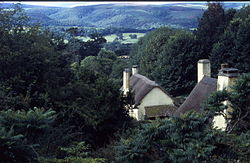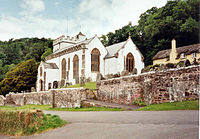Difference between revisions of "Selworthy"
(Created page with "{{Infobox town |name=Selworthy |county=Somerset |picture=Selworthytevillage.jpg |picture caption=Selworthy |os grid ref=SS919468 |latitude=51.21015 |longitude=-3.548215 |popul...") |
(No difference)
|
Latest revision as of 09:03, 21 March 2024
| Selworthy | |
| Somerset | |
|---|---|
 Selworthy | |
| Location | |
| Grid reference: | SS919468 |
| Location: | 51°12’37"N, 3°32’54"W |
| Data | |
| Population: | 477 (2011) |
| Post town: | Minehead |
| Postcode: | TA24 |
| Dialling code: | 01643 |
| Local Government | |
| Council: | Somerset |
| Parliamentary constituency: |
Bridgwater & W. Somerset |
Selworthy is a tiny village in the west of Somerset, teetering on the scarp of the hills that loom over the sea in dramatic cliffs a mile and a half to the north. The village is three miles west of Minehead, and within the National Trust's Holnicote Estate on the northern fringes of Exmoor.
The parish includes such hamlets as Bossington, Tivington, Lynch, Brandish Street and Allerford.
At 1,010 feet, Selworthy Beacon, rising above the village, is one of the highest points on Exmoor. Near the summit are a series of cairns, thought to be the remains of round barrows,[1] and the Iron Age Bury Castle.[2]
Bossington is separated from Porlock Bay by a shingle beach, through which flows the River Horner, forming part of the 'Porlock Ridge and Saltmarsh' Site of Special Scientific Interest. In the 1990s, rising sea levels created salt marshes, and lagoons developed in the area behind the boulder bank.[3][4]
The village is on the South West Coast Path.
History
The name of the village means 'sallow (or willow) enclosure (or settlement)'. In the Domesday Book it is recorded as Selewrda.[5] The manor was held by the widowed Queen Edith in 1066, and, with Luccombe, was awarded to Ralph de Limesy by King William. In 1301, Edward I awarded the manor to Henry de Pynkeny.[6] It passed down through the family until acquired by marriage by Sir Thomas Dyke Acland in 1802.[7]
Selworthy was rebuilt by Sir Thomas Acland in 1828 as a model village, to provide housing for the aged and infirm of the Holnicote Estate. It was effected in a similar style to Blaise Hamlet, Bristol, which had been built a few years earlier.[2] One of the cottages, known as Periwinkle Cottage, is now an award-winning tea room.[8] Many of the other cottages, whose walls are painted with limewash that has been tinted creamy yellow with ochre, some of which are now rented out, are still thatched and are listed buildings.[9][10][11]
The village and the surrounding Holnicote estate was given to the National Trust in 1944 by Sir Richard Acland, having been passed down through the Acland family for nearly 200 years.[7]
Few of the buildings preceding 1828 survive, but those that do include the church, the tithe barn and Tithe Barn Cottage.[12]
Church
On the hill above the village is the whitewashed 15th-century Church of All Saints, with a 14th-century tower. The pulpit includes a 17th-century hourglass and the iron-bound parish chest dates from the same time.[13] Within the church is a copy of the Chained Book of 1609 by Bishop John Jewel, entitled Defense of the Apologie of the Church of England.[14]
The church is a Grade I listed building.[15]
In the churchyard stands a mediæval cross with three octagonal steps, a square socket, and an octagonal shaft. The head is missing.[1][16] The churchyard provides views across the valley to Somerset's highest point, Dunkery Beacon.[2]
The thatched Chapel of St Leonard, Tivington was built in the mid 14th century as a chapel of ease. It is a Grade II* listed building.[17]
The Lynch Chapel Of Ease at West Lynch dates from around 1530.[18]
Pictures
| ("Wikimedia Commons" has material about Selworthy) |
Outside links
References
- ↑ 1.0 1.1 Adkins, Lesley; Adkins, Roy (1992). A Field Guide to Somerset Archaeology. Wimborne, Dorset: Dovecote Press. pp. 101. ISBN 0-946159-94-7.
- ↑ 2.0 2.1 2.2 Dunning, Robert (1980). Somerset and Avon. Edinburgh: John Bartholomew & Son. pp. 125. ISBN 0-7028-8380-8.
- ↑ Lincoln Archer (April 28, 2005). "Letting nature take its course". BBC News. http://news.bbc.co.uk/1/hi/uk/4493447.stm.
- ↑ "Shifting shores in the South West". National Trust. Archived from the original on 6 December 2008. https://web.archive.org/web/20081206034626/http://www.nationaltrust.org.uk/main/w-coastal-issues.pdf. Retrieved 13 October 2008.
- ↑ "Selworthy Parish". Exmoor National Park. Archived from the original on 16 July 2011. https://web.archive.org/web/20110716113759/http://www.exmoor-nationalpark.gov.uk/index/looking_after/living_in_communities/exmoor_parishes/selworthy_parish.htm. Retrieved 26 January 2008.
- ↑ Savage, James (1830). History of the Hundred of Carhampton: In the County of Somerset. Longman, Rees, Orme, Brown, & Green. pp. 182–196. https://archive.org/details/historyhundredc01savagoog.
- ↑ 7.0 7.1 Morgan Evans, David; Salway, Peter; Thackray, David (1996). The Remains of Distant Times: Archaeology and the National Trust. Boydell & Brewer. pp. 73–83. ISBN 0-85115-671-1.
- ↑ National Heritage List 1058026: Periwinkle Cottage Tea Rooms (Grade II listing)
- ↑ National Heritage List 1057988: No 1 Lower Cottage and Greenbanks (Grade II listing)
- ↑ National Heritage List 1058025: Cottage (National Trust Estate No 68) (Grade II listing)
- ↑ National Heritage List 1345423: Selworthy Cottage and wall abutting on south front returned to road (Grade II listing)
- ↑ National Heritage List 1057990: The Tithe Barn and Tithe Barn Cottage (Grade II* listing)
- ↑ "Selworthy". Pictures of England. http://www.picturesofengland.com/England/Somerset/Selworthy_Green. Retrieved 26 January 2008.
- ↑ "Selworthy". Everything Exmoor. http://www.everythingexmoor.org.uk/_S/Selworthy.php. Retrieved 26 January 2008.
- ↑ National Heritage List 1296005: Church of All Saints (Grade I listing)
- ↑ National Heritage List 1058028: Remains of churchyard cross (Grade II* listing)
- ↑ National Heritage List 1345394: Chapel of St Leonard (Grade II* listing)
- ↑ National Heritage List 1057997: Selworthy
- Haw, Graham (2001). The Book of Luccombe & Selworthy.
- Reminiscences of an Old West Country Clergyman by W H Thornton (edited by Duff Hart-Davis), Ludlow 2010. Thornton lived at Selworthy in the 1840s


